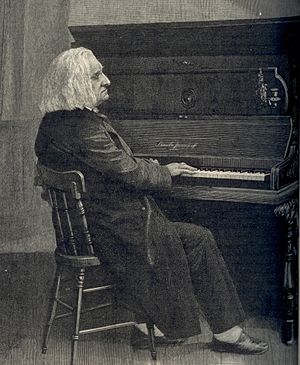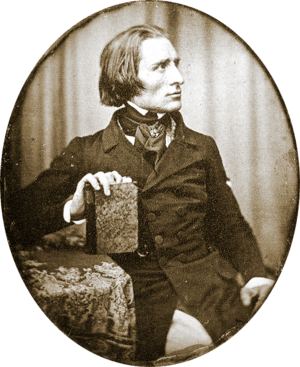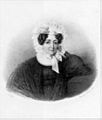Franz Liszt facts for kids
Franz Liszt (born in Raiding, near Sopron, October 22, 1811; died in Bayreuth, July 31, 1886) was a Hungarian composer and pianist. Liszt (pronounced like “list”) was one of the most important musicians of the 19th century. He was known as the greatest pianist of his time. He traveled all over Europe, and people filled concert halls to hear him play.
Liszt wrote a lot of music for the piano. Many of his piano pieces were much harder to play than anything written before. He helped develop new ways of playing the piano, setting high standards for future musicians. He also used new and modern ideas in his compositions. Liszt was very kind and helpful to other composers. He helped them become famous by conducting their music and playing their orchestral pieces on the piano.
Early Life
Liszt’s father worked for Prince Nikolaus Esterházy. This was the same noble family who employed the famous composer Joseph Haydn. When Franz was seven, his father began teaching him the piano. Franz was a child prodigy, meaning he was incredibly talented at a young age. Within a year or two, he was already performing in concerts. He was so promising that some wealthy Hungarians offered to pay for his music education.
In 1821, his family moved to Vienna. He took piano lessons from Carl Czerny and composition lessons from Antonio Salieri. Even as a young boy, he quickly became famous. He met well-known musicians like Ludwig van Beethoven and Franz Schubert. It is said that Beethoven even kissed him on the forehead.
In 1823, his family moved again, this time to Paris. He wanted to study music at the Conservatoire. However, Luigi Cherubini did not allow him to join because he was a foreigner (not French). So, Liszt studied music theory privately with Reicha and composition with Paer. Soon, everyone in Paris wanted him to play the piano. He also traveled to London. On his second visit there in 1825, he played for King George IV at Windsor.
Liszt continued to travel to other countries. After his father passed away, he became a piano teacher in Paris. He read many books to educate himself. In 1831, he met the amazing violinist Niccolò Paganini. Liszt was incredibly impressed by Paganini’s virtuoso playing. Liszt wanted to do for the piano what Paganini had done for the violin. Both men were known for writing music that was incredibly difficult to play on their instruments.
Liszt later met a Countess named Marie d’Agoult. They lived together for several years and had three children. Liszt was very generous and gave a lot of his money to help pay for a monument to Beethoven in Bonn. To earn money, he had to go on concert tours again. The Countess eventually left him. They continued to see each other and their children for a few summers, but eventually, they separated completely.
Later Life
Liszt spent eight years living in Rome. He wrote a lot of religious music.
For most of his later years, Liszt traveled between three cities: Rome, Weimar, and Budapest. He called this his “vie trifurquée,” which means "three-forked life." He passed away in Bayreuth on July 31, 1886.
His Personality
Liszt had a very strong personality that impressed everyone he met. When he played the piano at concerts, he was a great showman. Many people drew caricatures of him playing, often showing his wild hair. He was very polite and knew how to get along with important people. He was also very generous, often giving money and time to other musicians. He always gave praise when it was deserved. Liszt was a powerful and unique person. He was one of the most important Romantic composers of his time, especially known for his dazzling piano performances.
Compositions


Most of Liszt’s compositions were for the piano. He wrote one piano sonata in B minor. Its structure was very different from sonatas by composers like Beethoven. It is a very Romantic piece, but it does not tell a specific story. Most of his piano works are shorter pieces with a free form. He often took a musical theme and transformed it, changing it gradually.
He wrote studies that were much more than just exercises to improve piano technique. One famous collection is called Transcendental Studies. In Switzerland, he wrote Années de pèlerinage (Years of Wandering), a collection of pieces he later gave titles to. Liszt explored all the possible sounds the piano could make, as it was still a fairly new instrument. Sometimes, he made the piano sound like an entire orchestra. Some of his last piano works are simpler to play, but their chords sounded very modern for his time. They are similar to the Impressionistic music of Claude Debussy.
Not all of Liszt’s piano pieces were original compositions. He also made arrangements or transcriptions. It might seem strange to us now to take someone else’s symphony and arrange it for piano. But Liszt often did this. He took symphonies by Beethoven or songs by Schubert and changed them so they could be played on the piano. Many people did not have the chance to hear concerts often, and they certainly did not have radios or CDs. So, Liszt helped make these works more famous by bringing them to a wider audience. He often made difficult transcriptions, adding many extra notes and creating a new piece from an old one.
Liszt’s orchestral music is also very important. He wrote symphonic poems, which are pieces that tell a story or describe something. His best-known symphonic poem is called Les préludes. He also wrote two piano concertos.
He wrote a lot of church music. While church music in those days was often quite emotional, Liszt tried to make his works inspire true religious feeling.
Conclusion
In many ways, Liszt was a typical Romantic artist. He was always searching for a deeper meaning in life. He was a 19th-century musician, but his ideas and music looked forward to the 20th century.
Images for kids
-
Liszt Ferenc Academy of Music in Budapest
-
Liszt in March 1886, four months before his death, photographed by Nadar
See also
 In Spanish: Franz Liszt para niños
In Spanish: Franz Liszt para niños












